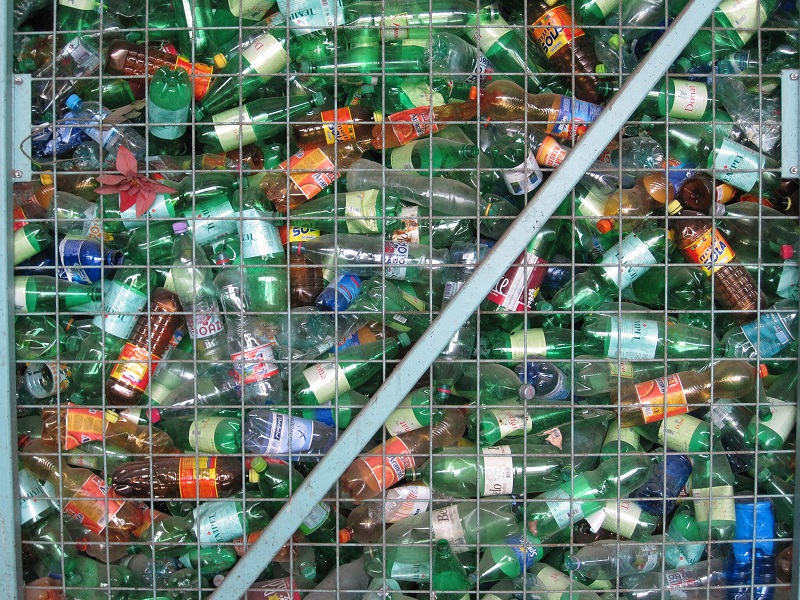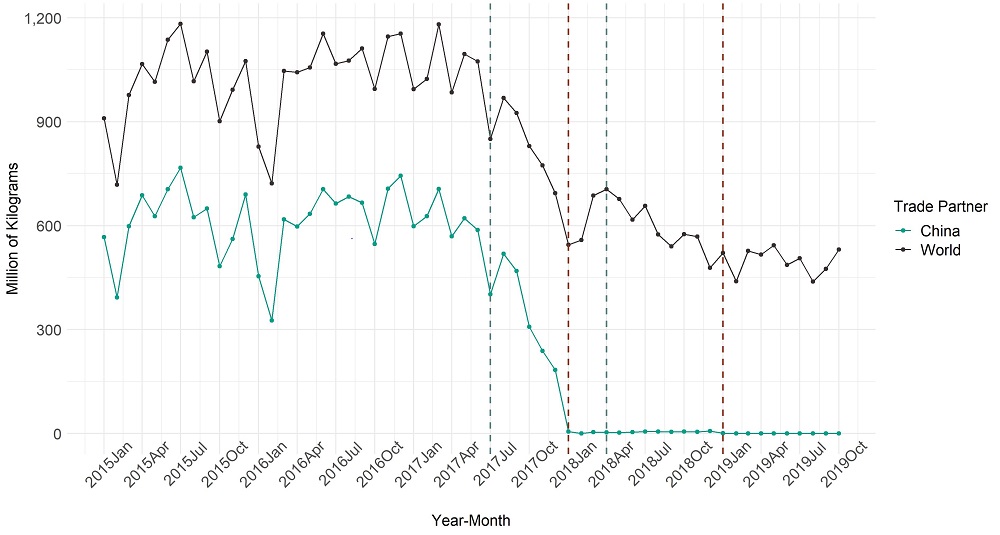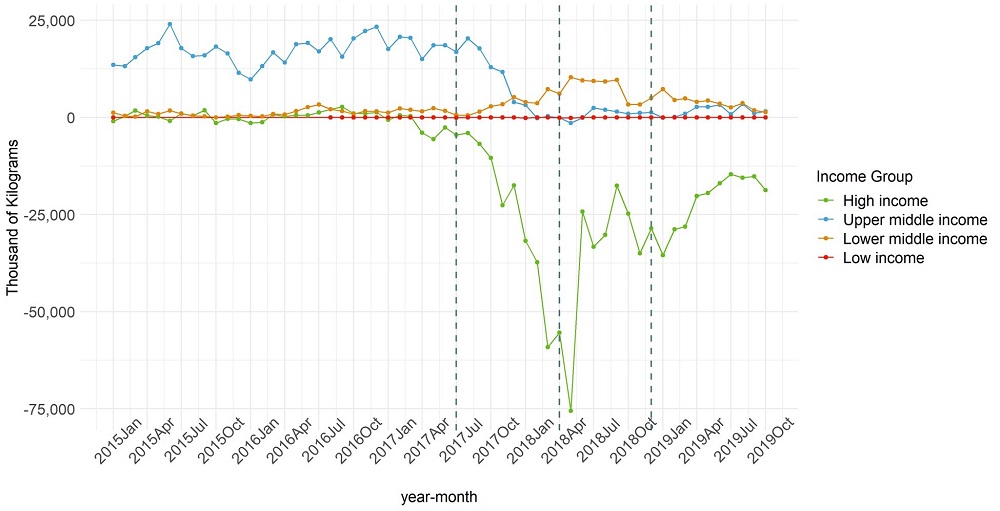IDE Research Columns
Column
Waste Havens in the Global Plastic Waste Trade

Pukitta CHUNSUTTIWAT and Ian COXHEAD
Keystone Strategy LLC; Institute of Developing Economies
May 2024
In 2018, China disrupted global trade in waste plastic by banning imports. Exporters were forced to seek new destinations. The waste haven hypothesis says that net exports will grow to countries that are poorer and/or have weaker environmental regulations. In this research we ask whether plastic waste trade exhibits such a pattern, and how trade changed following China’s ban. Empirical analysis supports the waste haven hypothesis and shows that the ban exacerbated this pattern. It is likely that post-ban trade increases exceeded demand for waste as feedstock to recycled plastic production, thereby increasing likelihood of disposal in importing countries. Therefore, because importers generally have weaker environmental regulations, the new trade pattern may worsen the global plastic pollution crisis.
Motivation
Highly visible plastic waste accumulations such as the Great Pacific Garbage Patch capture media and public attention. However, the great majority of plastic waste disposal is more mundane and less visible: in landfills and illegal disposal sites, including rivers and coastal waters, especially in the developing world. Plastic waste has an expected lifespan measured in centuries. It threatens wildlife and habitats, and microplastics and plastic microfibers are now found in every corner of the world and throughout the food chain. Given these actual and potential harms, where plastic waste comes to rest is a global policy problem.
In an environmentally fair distribution of plastic waste, each location’s exposure to this source of pollution would be proportional to its contribution to supply. However, trade enables global redistribution. Where does traded plastic waste go, and why?
China’s Market-Disrupting Import Ban
In the first two decades of this century, more than half of the world's traded plastic waste was exported to China, where it was either bought by recyclers for the manufacture of new plastic products, or simply dumped. In mid-2017, however, China announced its intent to prohibit plastic waste imports. The ban, which came into force in January 2018, forced many countries to seek new ways to deal with plastic waste, including new destinations for exports. Figure 1 shows the impact of the policy on trade. China’s import volume dropped to zero within a few months of the announcement. World imports also fell, but by a lot less. Since the ban did not reduce plastic waste production, the trend in world exports indicates that part of the plastic waste formerly exported to China was being absorbed by the sending countries, while the remainder was being diverted to other destinations.

Figure 1. Plastic Waste Import Volume, China and the World, Jan. 2015–Oct. 2019.
Note: Vertical lines show (in order) China’s ban announcement; ban effective date; announcement of coverage expansion to additional product lines; effective date of expanded coverage.
Source: Authors’ calculation based on UN COMTRADE data.
In the developing world, several countries experienced sharp spikes in import volumes, especially coming from high-income countries. Figure 2 shows these data for one heavily affected country, Thailand.

Figure 2. Thailand: Plastic Waste Net Exports by Partner Income Group, Jan. 2015–Oct. 2019.
Note: Vertical lines show (in order) China’s ban announcement; ban effective date;
effective date of expanded coverage.
Source: Authors’ calculation based on UN COMTRADE data.
In the medium run, plastic recycling capacity outside China would have been inadequate to absorb all the additional waste. We don’t have data on how much additional dumping took place. What we do know, however, is that the costs of dumping—like the costs of sorting, the first step in the recycling process—vary across countries. Labor costs and environmental regulations are probably the key sources of those differences. Wealthier countries have higher labor costs, and frequently also have higher dumping costs because that activity is more strictly regulated. These factors motivate the search for new export destinations, often in poorer and/or less well-regulated countries.
Measuring Trade Responses
In our study we first ask whether global plastic waste trade follows a waste haven pattern, shifting environmental burden from richer countries and those with better environmental regulations to those that are poorer and/or have weaker regulations. Second, we evaluate how the country composition of global plastic waste trade changed after China’s ban was imposed. Based on our findings, we offer some insights on the consequences of the global plastic waste trade for economic welfare and the spatial distribution of environmental harm.
To understand the issues, we first model technology and behavior by key actors at both ends of the plastic waste trade. Reclaimers are companies with contracts to collect, sort, clean and sell or dispose of recyclable waste. Some of their output is sent to landfills, and the remainder is sold to recyclers, which are companies that purchase waste plastic as an input to production of post-consumer resin (PCR) pellets for use by manufacturers of plastic products. Reclaimers are typically located in wealthy countries, and most such countries are net exporters of plastic waste. Recyclers may be located anywhere, but many are found in developing countries, especially (since China’s ban) in the Southeast Asian region. We show how the ban altered reclaimer behavior by changing the relative price of cleaning and selling plastic waste (including, in some cases, exporting it) versus simply dumping it in landfills or equivalent sites. Likewise, the ban altered global waste prices and the profitability of recycler activities, especially in the developing world.
Our empirical estimation uses the gravity model of international trade, in which bilateral trade flows are explained by the relative sizes of the trading economies and the inverse of the distance between them. We augment the standard model with international data on the stringency of environmental regulations. Empirical analysis using the augmented gravity model confirms that global plastic waste trade follows a waste haven pattern, and the imposition of China’s import ban exacerbated this relationship. Differences in per capita GDP were important drivers of bilateral trade both before and after the ban, and the typical direction of trade was from richer to poorer countries. After the ban, country-level disparities in the stringency of environmental regulations also became influential, with waste trade flowing from more to less strictly regulated regimes.
Given that post-ban import volumes far exceeded pre-ban volumes in many countries, these results raise two concerns. First, post-ban trade changes were seemingly driven by exporters' demand for waste disposal services rather than by demand by recyclers, thereby increasing environmental burden in importing countries. Second, because countries with weak environmental regulations likely have underdeveloped systems for solid waste management, the new pattern of plastic waste redistribution is likely to have exacerbated the existing global plastic waste pollution crisis. That is, if recycling capacity in the new destinations is insufficient to accommodate all the diverted trade, then it is likely that some of the additional waste imports were simply dumped, to the detriment of local environmental quality and the welfare of host-country populations.
Initial import spikes were quite short-lived, but the altered pattern of trade appears to be persistent. Will the waste haven effect remain? Several host countries responded to sharp increases in waste imports by announcing their own restrictions on additional shipments. Investment in additional recycling capacity may also have increased, both in wealthy and poorer countries. However, country-level differences in per capita income (our proxy for labor costs) and in the stringency of environmental regulation have remained stable, providing a basis for ongoing trade.
Global Policy Responses
The global community has responded. A 2019 amendment to the Basel Convention1 on global trade in waste products mandates that plastic waste be recycled or disposed of “as close as possible to source'' and aims to regularize waste trade and international disposal through a procedure of “prior informed consent'' between exporters and importers (Benson and Mortensen 2021). However, these measures were to be implemented only from 2021, and some very large waste exporters are not signatories. It is still too early to judge whether international efforts will have an impact on plastic waste trade.
Looking Forward
The supply chain from recycling bins to post-consumer resin (PCR) production is long and complex, and no study can adequately account for all its links. We have modeled and estimated the drivers of bilateral trade and of changes in that trade following a major policy shock. Related and ongoing work addresses empirical measures of reclaimers' demand for plastic scrap as raw material, for example recycling capacity (Kojima 2020); this will facilitate estimation of the extent to which post-ban trade diversion is determined by demand for plastic scrap in importing countries. Similarly, a longer-run perspective will require examination of factors influencing post-ban investments in recycling capacity, waste disposal, and policy responses in the importing countries.
Authors’ Note
This column is based on Chunsuttiwat, Pukitta and Ian Coxhead. 2024. “Will You Take My (S)crap? Waste Havens in the Global Plastic Waste Trade.” Review of World Economics. https://doi.org/10.1007/s10290-024-00534-8
Note:
- Formally, the Basel Convention on the Control of Transboundary Movements of Hazardous Wastes and their Disposal.
References
Benson, Emily, and Sarah Mortensen. 2021. “The Basel Convention: From Hazardous Waste to Plastic Pollution.” Center for Strategic & International Studies, October 7, 2021. https://www.csis.org/analysis/basel-convention-hazardous-waste-plastic-pollution.
Kojima, Michikazu. 2020. “The Impact of Recyclable Waste Trade Restrictions on Producer Recycling Activities.” International Journal of Automation Technology 14(6):873–81.
* Thumbnail image: Plastic bottles for recycling (Radulf del Maresme, CC BY-SA 4.0, via Wikimedia Commons)
** The views expressed in the columns are those of the author(s) and do not represent the views of IDE-JETRO or the institutions with which the authors are affiliated.

